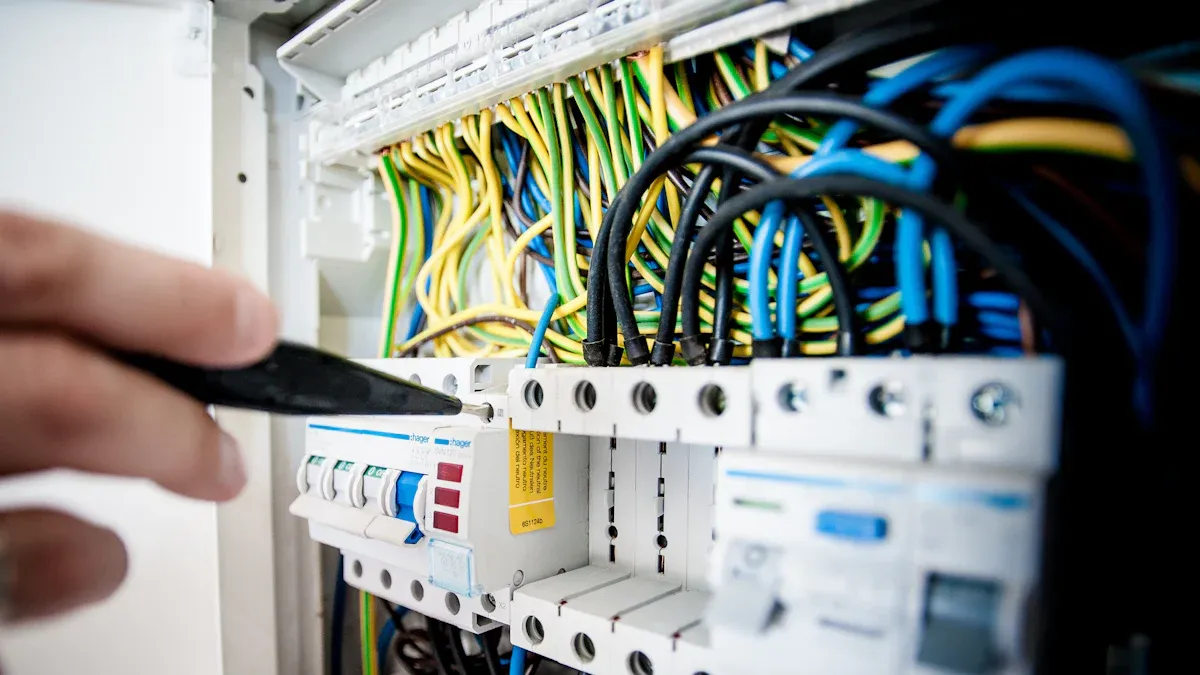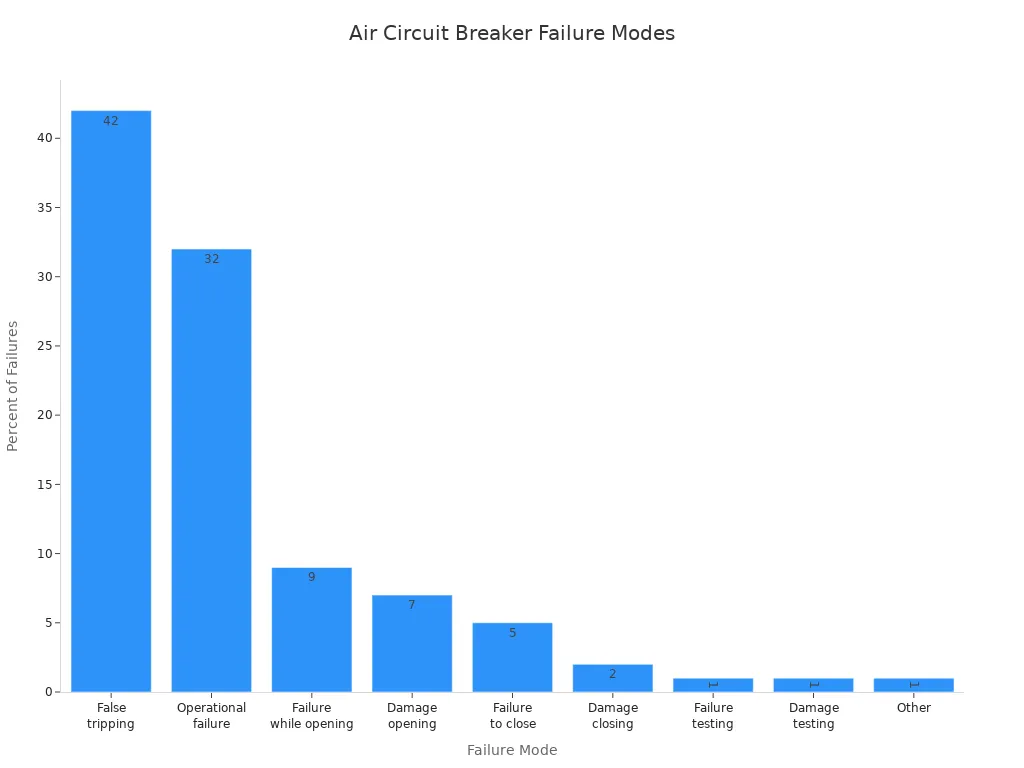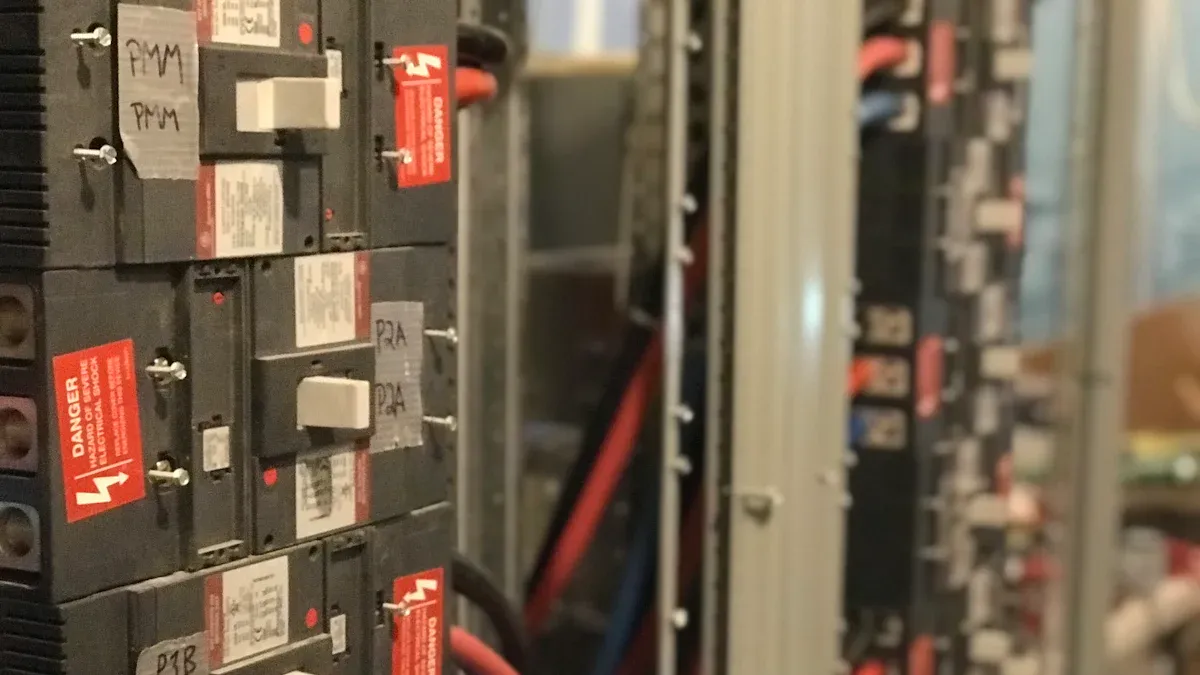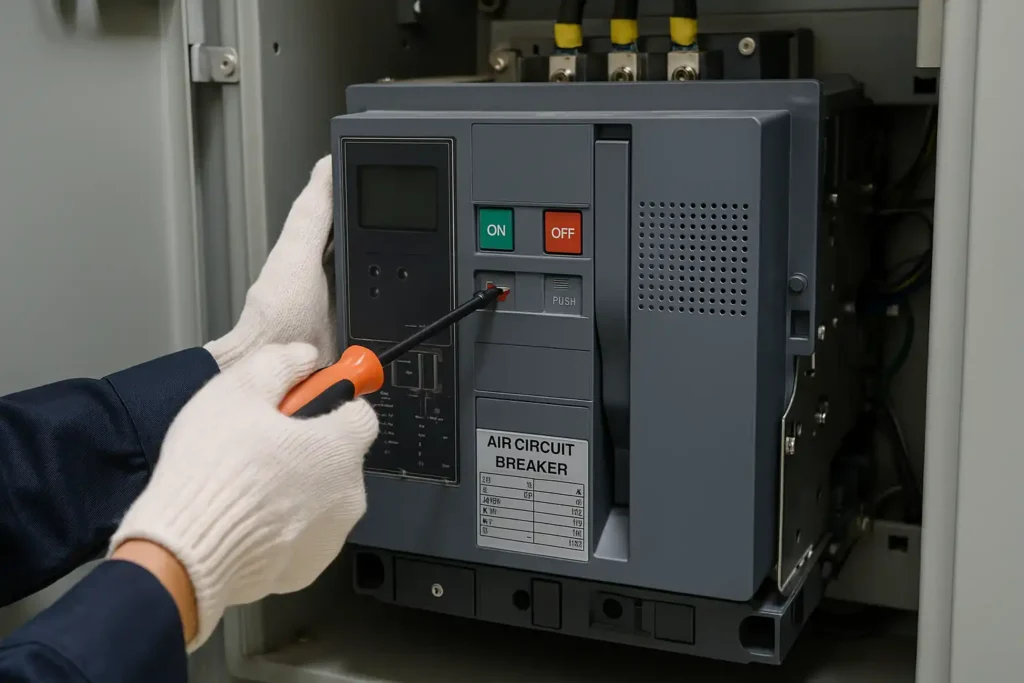You use air circuit breakers in places that need strong safety and steady power. Some common places are:
- Industrial areas like factories and power plants
- Commercial places like offices and hospitals
- Power plants and places that send out electricity
- Homes with smart technology and clean energy
Knowing when and why to use air circuit breakers helps you make safer systems. It also helps you stop expensive problems. You must pick the right breaker for your needs. This keeps your equipment safe.
Key Takeaways
- Air circuit breakers help keep electrical systems safe. They are used in factories, offices, power plants, and renewable energy sites. They stop dangerous currents very fast.
- Picking the right breaker means you must check voltage and current. You also need to look at the environment and safety rules. This helps protect equipment and stops expensive damage.
- Air circuit breakers can be used again after a problem. You can reset them. This saves money and cuts down on lost time. This is important in busy places like hospitals and transport systems.
- Checking and fixing air circuit breakers often stops problems. It helps power systems work well and stay safe.
- Air circuit breakers give strong and flexible protection. They have smart features. This makes them great for high-current, low-voltage jobs.
Industrial Applications

Distribution Panels
Air circuit breakers are found in many industrial distribution panels. These panels give power to big machines and tools. They need strong protection because they use a lot of electricity. If something goes wrong, the breaker must stop power fast. This helps stop damage or fire.
Here is a table with usual ratings for air circuit breakers in these panels:
| Parameter | Typical Values for Industrial ACBs |
|---|---|
| Rated Voltage | 400 V, 440 V, 690 V, up to 1000 V AC |
| Rated Current | From a few amps up to 6300 A and higher |
| Governing Standard | IEC 60947-2 |
You have to pick the right breaker for your system’s needs. If the breaker is too small, it might not work in a fault. If it is too big, you pay more than needed. Air circuit breakers help keep things safe and save money.
Plant Auxiliaries
Air circuit breakers protect plant auxiliaries like motor control centers, transformers, and power panels. These breakers stop too much current and short circuits. This keeps your equipment safe and your plant working well. They are made to handle high currents and break dangerous arcs. This is important in places where fire or explosions can happen.
Note: In risky places like chemical plants or oil refineries, you need explosion-proof breakers. These breakers have strong cases that keep sparks inside. This stops fires from starting. The National Electric Code (NEC) has rules for these places. It uses Classes and Divisions to show how risky an area is.
Here is a table that compares air circuit breakers and vacuum circuit breakers:
| Feature | Air Circuit Breaker (ACB) | Vacuum Circuit Breaker (VCB) |
|---|---|---|
| Voltage Range | Suitable for low to medium voltage (under 690V) | Suitable for medium to high voltage (3.3kV+) |
| Initial Cost | Lower initial cost | Higher initial cost |
| Maintenance | Needs more frequent maintenance | Needs less maintenance |
| Application | Used in low-voltage systems | Used in high-voltage systems |
You use air circuit breakers when you want good, low-voltage protection and want to save money. They are used in factories, warehouses, and places that need strong safety.
Commercial and Infrastructure
Office Buildings
Air circuit breakers are used in big office buildings. These buildings need steady power for lights, elevators, computers, and HVAC. Air circuit breakers keep these systems safe from too much current or short circuits. You can change their trip settings to fit your building’s needs. This helps stop power cuts that are not needed. It also keeps your building running well.
Many businesses like air circuit breakers because they handle lots of current. You can use them again after a problem. This saves money and time because you do not need to buy new ones each time. Their strong build and smart features are good for places with lots of power use, like hospitals and data centers.
Here are some reasons people pick air circuit breakers in businesses:
- They handle big currents for large machines.
- You can set trip levels for your needs.
- You can use them again after a fault, which saves money.
- They work with control systems for better checks.
- They help manage power well in busy places.
Tip: Air circuit breakers let you watch and find problems from far away. This helps you fix things faster and keeps power on.
Transportation Systems
Air circuit breakers are important in railways and airports. These places need safe and steady power for trains, signals, lights, and airport tools. Air circuit breakers stop problems like overloads and short circuits. This helps keep trains and planes running without stops.
Modern transport uses smart circuit protection. Air circuit breakers can trip only the part with a problem. The rest of the system keeps working. This means less time with no power. Their strong design meets tough rules. They work well in places with shaking, heat changes, and electrical noise.

Common problems in these places are false trips, not working right, and worn contacts. You should check and fix your breakers often to keep things safe and working well.
Power and Energy

Power Plants
Air circuit breakers are used in many power plants. They help protect important equipment and keep the plant safe. These breakers notice problems like too much current or short circuits. When something goes wrong, the breaker trips and stops electricity. This keeps generators and transformers from getting damaged.
Here is how air circuit breakers help power systems:
- Sensors or relays find faults like overcurrent or short circuits.
- The trip part works and opens the contacts to stop power.
- The arc chute cools and splits the arc to make it safe.
- After fixing the issue, you can reset the breaker by hand or with a machine.
There are different air circuit breakers in power plants. The table below shows some types and where they are used:
| Air Circuit Breaker Type | Voltage Range | Current Range | Typical Applications and Notes |
|---|---|---|---|
| Standard Air Circuit Breaker | Below 450V (low voltage) | 800A to 10,000A | Used in distribution panels, low voltage power plant auxiliaries |
| General Low Voltage Air Breakers | Up to 600V AC | 400A to 6300A or larger | Protection for UPS, generators, mini power stations |
| Magnetic Blowout Air Circuit Breaker | Up to 11kV | N/A | Uses magnetic field to extend arc, common up to 11kV |
| Air Blast Circuit Breaker | 245kV to 420kV and above | N/A | High voltage systems requiring fast operation, lower maintenance |
| General Use | Up to 12kV (AC/DC) | N/A | Protection of transformers, capacitors, generators in plants with fire/explosion hazards |
You should check and take care of these breakers often. Worn parts, dirt, or heat can make them fail. Cleaning, testing, and looking at them helps keep everything safe.
Renewable Installations
Air circuit breakers are also used in wind farms and solar plants. These places need strong protection because weather and power can change fast. Air circuit breakers keep wind turbines, solar panels, and other equipment safe.
- Air circuit breakers and vacuum circuit breakers protect wind and solar equipment from too much current.
- DC circuit breakers help control and protect solar systems.
- These breakers keep things safe, even in bad weather or dirty places.
- They help connect renewable energy to the grid and keep power steady.
In wind farms, special breakers help match wind power to the grid. They can turn turbines on or off quickly. This helps keep the grid balanced and stable. These breakers have strong cases to handle salt, wind, and rain. They also have sensors to watch for heat and other issues.
Note: You need to check and care for breakers in renewable sites often. Weather, water, and dust can cause problems. Taking care of them helps stop failures and keeps power on.
When to Use Air Circuit Breakers
Key Selection Factors
You need to know when to use air circuit breakers in your electrical system. These breakers work best in places that need strong protection and high reliability. You should look at several factors before you choose them:
- Electrical characteristics matter. You must check the voltage rating, frequency, and how much current the breaker can handle. Air circuit breakers often have high interrupting capacity, which means they can stop large fault currents quickly.
- Environmental conditions affect your choice. If your system is in a hot place, you need a breaker that works well at high temperatures. Some air circuit breakers are made for 104°F or higher. In wet or corrosive areas, you can pick breakers with special coatings to stop rust and damage.
- Mechanical shock is important. If your equipment shakes or moves, you need a breaker with anti-shock features. Air circuit breakers can come with these options.
- Altitude changes how well a breaker works. At higher places, the air is thinner, so the breaker may need to be derated. You must check the ratings for your location.
- Maintenance and testing standards help keep your system safe. Air circuit breakers that meet UL or IEC 60947-2 standards give you confidence in their performance.
- You should also think about the type of load. Motors, lights, and transformers all have different needs. Air circuit breakers can be adjusted for many types of loads.
- If you need remote control or extra contacts, air circuit breakers often support these features. This helps you manage your system better.
Tip: Always check the short-circuit breaking capacity. The breaker must handle the highest possible fault current in your system.
Industry standards like IEC 60947-2 and UL certifications set the rules for air circuit breakers. These standards make sure the breaker can stop dangerous currents and put out arcs safely. You should use air circuit breakers when your system needs high breaking capacity, strong arc control, and reliable performance in tough environments.
Here is a table that shows some limits of air circuit breakers:
| Limitation/Disadvantage | Explanation |
|---|---|
| Size and Weight | Air circuit breakers are larger and heavier than some alternatives, so they may not fit in small spaces. |
| Noise and Arcing | They make noise and create arcs when they operate, which can be a problem in quiet or sensitive areas. |
| Maintenance | You need to check and service them often to keep them working well. |
| Initial Cost | They cost more at the start compared to other breakers. |
| Short-Circuit Endurance | They may need extra protection for very high fault currents. |
You should use air circuit breakers when your system needs high current protection, adjustable settings, and strong safety features. If you have limited space or need a quiet system, you may want to look at other types.
Safety and Reliability
You want your electrical system to be safe and reliable. Air circuit breakers help you reach this goal in many ways:
- They protect against overloads, short circuits, and other faults. This keeps your equipment and people safe.
- You can adjust the trip settings. This lets you fine-tune the protection for your needs.
- Air circuit breakers can handle high currents. They work well in large factories, power plants, and busy buildings.
- After a fault, you can reset and use air circuit breakers again. This saves you money because you do not need to buy new ones each time.
- These breakers last a long time and can handle tough conditions like heat, dust, and moisture.
- You can operate them from a distance. This keeps you safe during maintenance or emergencies.
- Air circuit breakers use air blast and arc chutes to put out arcs quickly. This stops damage and keeps your system running.
You also get other benefits:
- They meet strict safety rules and help protect both people and machines.
- You can add them to new or old systems easily.
- They do not use harmful gases, so they are better for the environment.
- Their strong build and easy maintenance mean less downtime and lower costs.
Note: Regular checks and cleaning help keep air circuit breakers safe and reliable. Always follow the maker’s instructions for the best results.
You should use air circuit breakers when you need strong, adjustable, and reusable protection. They give you peace of mind in places where safety and uptime matter most.
Comparison with Other Breakers
Molded Case vs. Air Circuit Breakers
Molded case circuit breakers and air circuit breakers are different in many ways. Molded case circuit breakers are smaller and fit in tight spaces. They are good for small loads and branch circuits. You often see them in motor protection or small panels. Air circuit breakers are bigger and need more room. They can handle much higher currents. They give better protection with more features. You find them in main distribution systems or near step-down transformers.
Here is a table that shows the main differences:
| Aspect | Molded Case Circuit Breaker (MCCB) | Air Circuit Breaker (ACB) |
|---|---|---|
| Size and Installation | Smaller, fits in tight spaces | Larger, needs more space |
| Rated Current Range | 10-800A | 400-6300A |
| Breaking Capacity | Lower | Higher |
| Protection Functions | Basic (overload, short circuit) | Advanced (grounding, undervoltage, phase loss, more) |
| Intelligent Features | Usually none | Includes monitoring, self-diagnosis, and communication |
| Typical Applications | Branch circuits, motor protection | Main distribution, high-level power systems |
| Short Circuit Class | Class A (no selective delay) | Class B (adjustable delay for selectivity) |
Tip: Pick an air circuit breaker if you need smart features. For simple jobs, a molded case circuit breaker is enough.
Vacuum vs. Air Circuit Breakers
Vacuum circuit breakers and air circuit breakers both stop dangerous currents. They do this in different ways. Vacuum circuit breakers use a sealed vacuum interrupter. This puts out arcs very fast and needs little care. Air circuit breakers use air and arc chutes to cool and split the arc. You must check and clean them more often.
Here is a quick comparison:
| Aspect | Vacuum Circuit Breaker (VCB) | Air Circuit Breaker (ACB) |
|---|---|---|
| Arc Extinguishing | Vacuum interrupter, fast and clean | Air and arc chutes, slower and more arc development |
| Maintenance | Minimal, sealed interrupter | Needs regular inspection and cleaning |
| Voltage Range | Medium-voltage (11kV to 33kV) | Low-voltage (400V to 800V) |
| Current Rating | Up to 4000A | Up to 6300A |
| Lifespan | Long, less contact wear | Moderate, more contact wear |
| Size | Compact, lightweight | Larger, heavier |
| Typical Applications | Substations, industrial plants, renewable substations | Industrial and commercial low-voltage power distribution |
- Vacuum circuit breakers are best for medium-voltage systems. They put out arcs fast and need less care.
- Air circuit breakers are good for low-voltage, high-current jobs. They are easy to check and fix.
Note: Choose a vacuum circuit breaker if you want less care and work with medium voltages. Use an air circuit breaker for low-voltage, high-current systems that need strong protection.
Air circuit breakers are used where you need strong and reliable protection. They work well in big factories, office buildings, and power systems. To pick the right breaker, you should do a few things. First, check the current and voltage ratings. Next, see if it has special trip features. Make sure it will fit in your panel. Plan to check and fix it often. Also, make sure it meets safety rules.
- Air circuit breakers help keep your system safe and working well.
- New designs let you watch them from far away and test them easily.
- Checking them often stops problems and keeps everyone safe.
FAQ
What is an air circuit breaker?
An air circuit breaker is a device that stops electricity when there is a problem. You use it to protect electrical systems from damage caused by too much current or short circuits.
What makes air circuit breakers different from other breakers?
You find air circuit breakers use air to put out the arc when they open. Other breakers, like vacuum or molded case types, use different materials or methods to stop the arc.
What should you check before choosing an air circuit breaker?
You should check the voltage, current rating, and breaking capacity. Make sure the breaker fits your system and meets safety standards. Always match the breaker to your equipment needs.
What maintenance do air circuit breakers need?
You need to clean, inspect, and test air circuit breakers often. Look for worn contacts, dust, or loose parts. Regular care helps keep your system safe and working well.
The following information may be of interest to you
How Air Circuit Breakers Differ from Vacuum Circuit Breakers
What is the highest rated circuit breaker?
Application and advantages of air circuit breakers
Comprehensive guide for wiring methods of air circuit breakers



